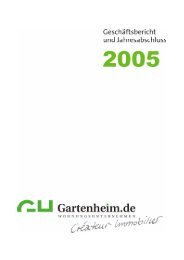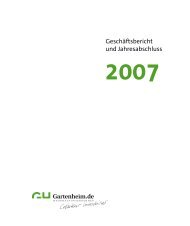analysis of the influences of solar radiation and façade glazing ...
analysis of the influences of solar radiation and façade glazing ...
analysis of the influences of solar radiation and façade glazing ...
You also want an ePaper? Increase the reach of your titles
YUMPU automatically turns print PDFs into web optimized ePapers that Google loves.
3.4 Testing <strong>of</strong> a building indoor environment during <strong>the</strong> warm period 87<br />
As seen in Fig. 3.38 <strong>and</strong> Fig. 3.39, a reduction <strong>of</strong> <strong>the</strong> <strong>glazing</strong> area in an optimal variant<br />
leads to a decrease in <strong>the</strong> operate temperature <strong>and</strong> raises <strong>the</strong>rmal comfort conditions. We<br />
can observe <strong>the</strong>se effects in apartments OG1 <strong>and</strong> OG2. In <strong>the</strong> calculation <strong>of</strong> <strong>the</strong> optimal<br />
value <strong>of</strong> WWR it is assumed that <strong>the</strong> south facing windows area in apartments OG3 <strong>and</strong><br />
OG4 were increased to <strong>the</strong> maximum. As it turned out, this assumption does not<br />
significantly influence <strong>the</strong> <strong>the</strong>rmal comfort in this part <strong>of</strong> <strong>the</strong> building. So, we can conclude<br />
that <strong>the</strong> optimal window-to-wall ratio, which was determined to achieve energy savings in<br />
heating periods, provides a better quality <strong>of</strong> <strong>the</strong>rmal environment during a warm season.<br />
In order to reduce <strong>the</strong> internal air temperature we can use intensive mechanical ventilation<br />
when <strong>the</strong> outdoor temperature is lower than <strong>the</strong> air temperature in <strong>the</strong> rooms. The next<br />
series <strong>of</strong> calculations were performed to investigate how a variable air volume system<br />
<strong>influences</strong> <strong>the</strong> <strong>the</strong>rmal environment in living spaces. The typical work schedule <strong>of</strong> a<br />
ventilation system with intensive night cooling in OG1 apartment for <strong>the</strong> last week <strong>of</strong> July<br />
is shown in Fig. 3.40. The total volume <strong>of</strong> outside air varied approximately between 60 <strong>and</strong><br />
210 m 3 /h. The maximum value <strong>of</strong> <strong>the</strong> flow rate appeared very <strong>of</strong>ten from 10 p.m. to 7 a.m.<br />
Practical results <strong>of</strong> a one-week operation <strong>of</strong> a VAV system <strong>and</strong> <strong>the</strong> comparison with<br />
constant air flow ventilation are demonstrated in Fig. 3.41. We observed that <strong>the</strong> amplitude<br />
between day <strong>and</strong> night internal air temperatures was significantly higher for <strong>the</strong> apartment<br />
with a variable air volume system. Due to this effect we could relatively quickly reduce<br />
<strong>and</strong> stabilize <strong>the</strong> air temperature inside <strong>the</strong> living spaces on a lower level.<br />
As shown in Fig. 3.42 <strong>the</strong> difference between <strong>the</strong> operate temperature in an apartment with<br />
<strong>the</strong> constant air volume system <strong>and</strong> with a night cooling system using <strong>the</strong> variable air<br />
volume flow grew from April to first half <strong>of</strong> June. This value stayed at approximately <strong>the</strong><br />
same level equal to about 3.5°C on <strong>the</strong> next period <strong>of</strong> warm season. The maximum value<br />
differed from 4.1°C for apartment OG2 to 4.4°C for apartment OG1 <strong>and</strong> <strong>the</strong> mean value<br />
differed from 2.7°C to 3.0°C, respectively.<br />
As it turned out, cooling by ambient air can be an energy saving solution. This ventilation<br />
system, coupled with external shading devices, is sufficient to prevent living spaces from<br />
excessive overheating during warm seasons.





